 |
 |
 |
| |
Risk of Heart Disease Appears to Off in Kaiser
|
| |
| |
Reported by Jules Levin
13th CROI
Feb 5-8, 2006, Denver
Improvement in modifiable traditional CHD risks can help to offset the effect of aging
Despite an aging cohort, mean 10-Year Framingham CHD risk has not increased over 5 years
-- Improved management of systolic blood pressure...
-- Improved management of total cholesterol... and modest rise in HDL...
-- Reduced smoking...
-- Changes in the use of Stavudine/D4T, Tenofovir/TDF and
-- Atazanavir/ATV, and increased use of lipid lowering therapy (LLT) are
likely to reduce the atherogenic effects of HIV treatment.
"Hospitalizations for CHD and MI among Northern California HIV+ and HIV- Men:Additional Follow-up, Changes in Practice and Framingham Risk Scores"
D. Klein*1, L. Hurley2, C. Quesenberry2, M. Silverberg2, M Horberg2, and S. Sidney2
Kaiser Permanente, Hayward, California, USA1 and Kaiser Permanente, Oakland, California, USA2
CONCLUSIONS
Significantly higher CHD / MI rates among HIV+ patients compared to HIV-negative patients.
Rates of CHD and MI are not significantly different in PI-unexposed vs. PI-exposed patients but increased risk with PI exposure is suggested.
Risk of MI appears to rise with increasing duration of PI exposure, but may
be easing in the longest duration category.
Changes in ART prescribing patterns, use of LLT and management of
traditional CHD risk factors appear to offset increase risk associated with
aging such that overall CHD risk is unchanged - at least in the near term.
Steady overall 10-year CHD risk is consistent with and may be associated
with the apparent tapering of MI events in recent years.
BACKGROUND
Coronary heart disease (CHD) continues to be a concern in the long term
care of HIV+ patients.
Ongoing monitoring of event rates, practice patterns and risk profiles is
warranted.
METHODS
Kaiser Permanente of Northern California (KPNC) has 3 million members
and has cared for 16,000 HIV+ members of whom over 5000 are currently
active.
We update estimates of CHD and myocardial infarction (MI) event rates
among HIV+ males through 6/30/2005 and compare them to rates among
HIV- male members.
We update our comparison of CHD/MI rates among protease inhibitor (PI) -
exposed and PI-unexposed HIV+ patients.
We report changes in the use of selected antiretoviral therapies (ART):
stavudine (D4T), tenofovir (TDF) and atazanavir (ATV); and changes in the
use of lipid lowering therapy (LLT).
We report changes in systolic blood pressure (SBP) control and smoking.
Measurements of individual CHD risk factors (age, smoking, SBP, total
cholesterol (TC) and HDL cholesterol) were used to estimate 10-year
Framingham Risk Scores (FRS) for CHD for 2000-2001, 2002-2003 and
2004-2005.
RESULTS
In 9.5 yrs of observation, 5430 HIV+'s had 140 CHD events (86 MIs) in
11,390 person years (PY) of non-PI follow-up (FU) (all time before PI start or
never PI, mean 2.3 yrs) and 15,527 PY of PI FU (all time after PI start, mean
4.5 yrs).
Age-adjusted CHD/MI rates for HIV+'s were higher than for HIV-'s (CHD: 6.0
vs. 2.9 events/1000 PY, p<.001; MI: 3.6 vs. 2.2, p=.002).
Rates for pre- and post-PI exposure continue to suggest increased risk
with PI exposure (CHD: 4.8 vs. 6.9, p=.088; MI: 3.0 vs. 4.2, p=.205).
Overall age-adjusted relative risk (RR) for MI was: 1.16 per year of PI
exposure (p=.112). Figure 2.
Percent of ART-treated pts on D4T fell from 49% to 12% (p<.001); percent
of ART-treated pts on TDF rose from 3% to 46% (p<.001); percent of PI-treated
pts on ATV rose from 6% to 35% (p<.001). Figure 3.
Percent of PI-treated pts on LLT rose from 1% to 27% (p<.001). Figure 4.
Mean cholesterol, HDL and systolic BP components of FRS each improved
from 2000-2001 to 2004-2005 (p<.001).
Percent current smokers changed from 21% in 2002-2003 to 18% in 2004-
2005.
v
Mean FRS did not increase from 2000-2001 to 2004-2005 (8.6% vs. 8.3%)
despite a significant rise in mean age (p<.001).
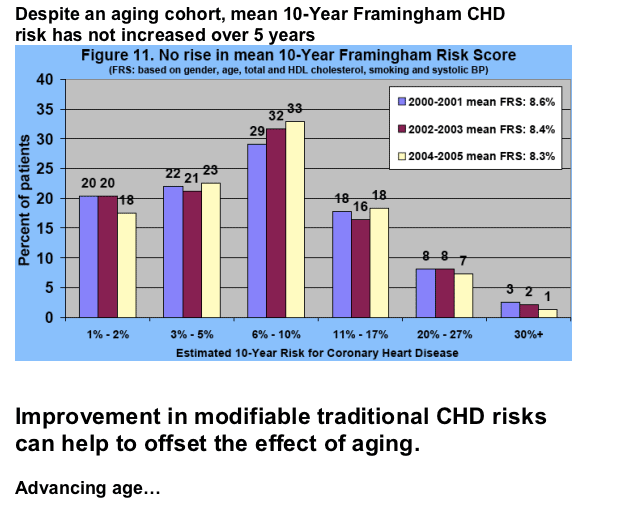
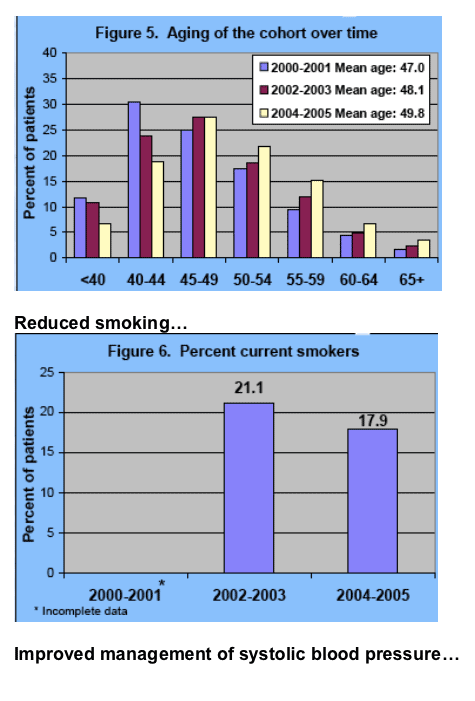
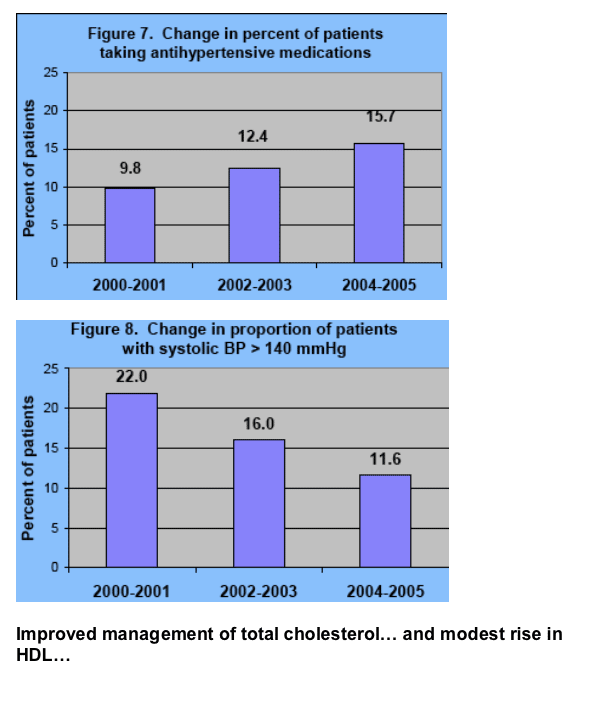
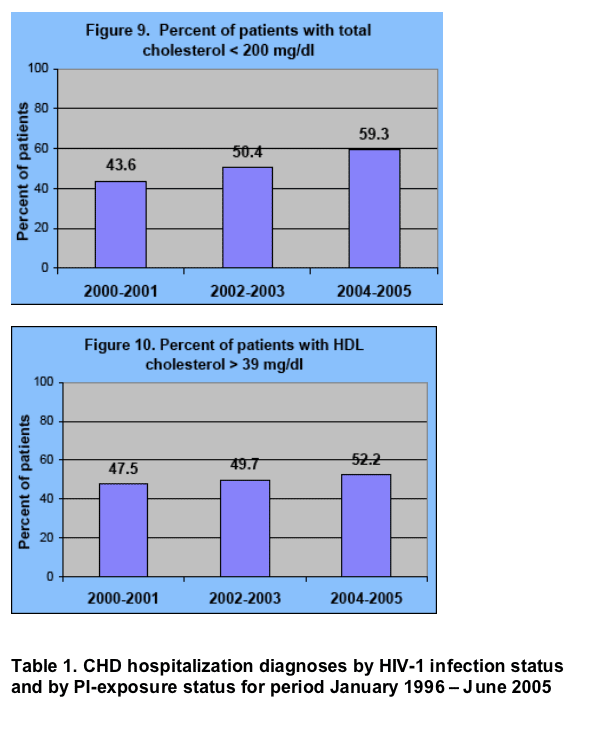
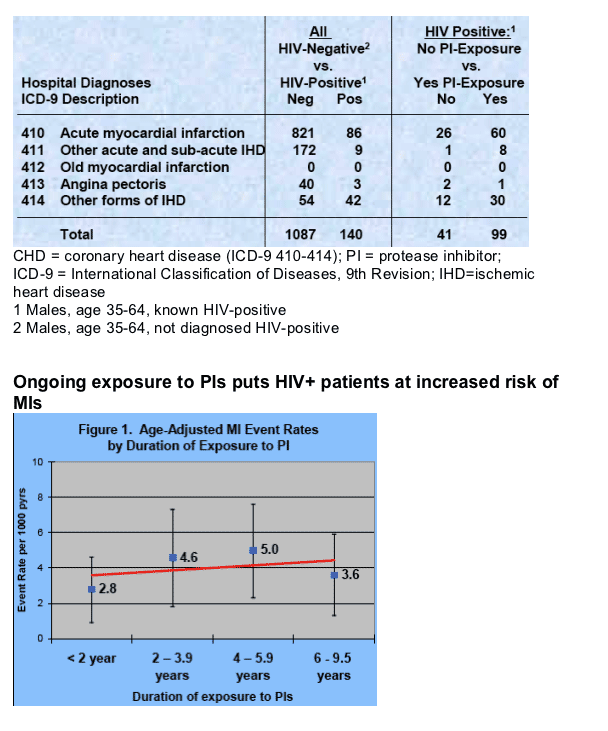
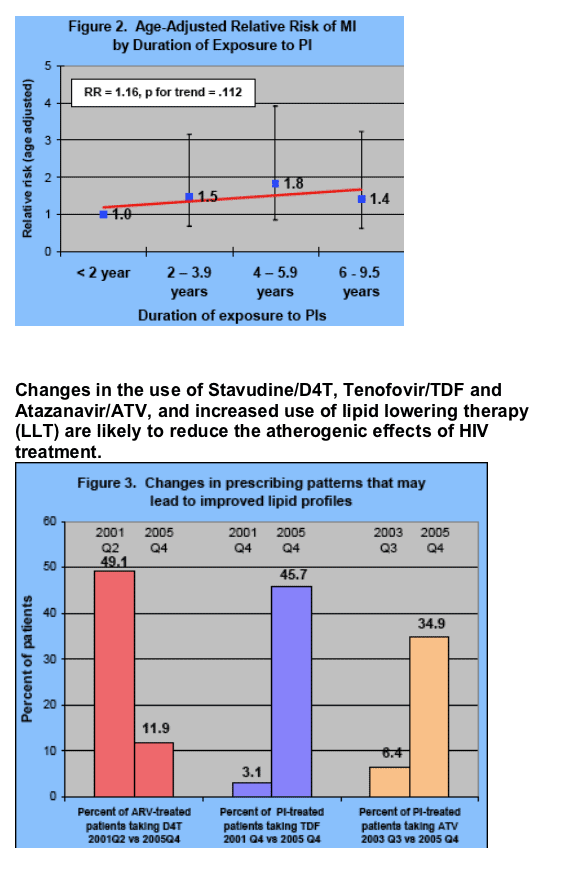
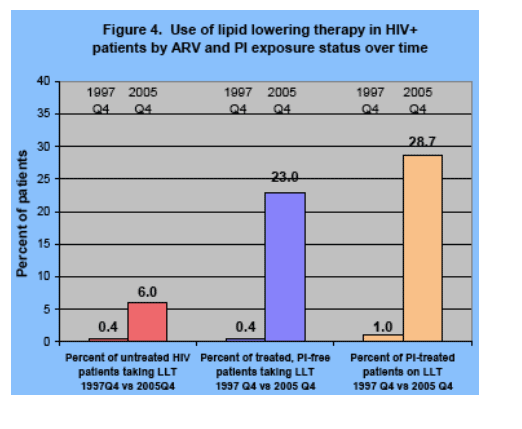
|
|
| |
| |
|
 |
 |
|
|